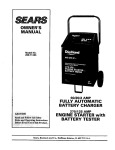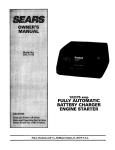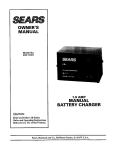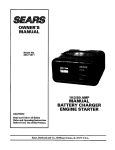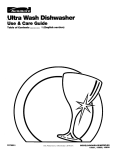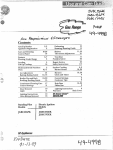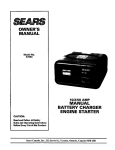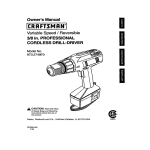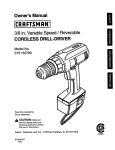Download Sears DieHard 200.71460 Owner`s manual
Transcript
h__ SEA/RS OWNER'S MANUAL Model No. 200.71460 60/20/2 AMP MANUAL BATTERY CHARGER CAUTION: 250/125 Read and Follow All Safety Rules and Operating Instructions Before Every Use of this Product. Sears, Roebuck AMP ENGINE STARTER with BATTERY TESTER and Co., Hoffman Estates, IL 60179 U.S.A. Table Of Contents Warranty .................................................................. 1 Using Your Battery Charger .................................... 7 Important Safety Instructions .................................. 2 Setting the controls .............................................. 7 Parts ......................................................................... 3 Charging your battery ........................................... 9 Before Using Your Battery Charger ........................ 4 Calculating charge time ...................................... 11 Assembling your charger ..................................... 4 Plugging it in ......................................................... 5 Using the engine start feature ............................ 12 Maintenance and care ........................................ 13 Using an extension cord ....................................... 6 Troubleshooting ..................................................... 14 Preparing your battery to be charged .................. 6 I Please read this Owner's Manual before using your Battery Charger The Sears model 200.71460, Manual Battery Charger/Tester/Engine Starter, offers a wide range of features to accommodate the needs for home or light commercial use. This manual will show you how to use your charger safely and effectively. Please read and follow these instructions and precautions carefully. Warranty FULL FIVE-YEAR WARRANTY If, within FIVE years from the date of purchase, this battery charger fails due to a defect in materials or workmanship, simply RETURN IT TO THE NEAREST SEARS STORE IN THE UNITED STATES, and Sears will repair or replace it, free of charge. This warranty gives you specific legal rights, and you may also have other rights which vary from state to state. Seam, Roebuck and Co., Dept 817WA, Hoffman Estates, IL 60179 I I Important Safety Instructions - SAVE THESE INSTRUCTIONS • Read all instructions and cautions printed on the battery charger, battery, and vehicle or equipment using battery. - • Do not disassemble charger. Take it to a qualified service professional if service or repair is required. Incorrect assembly may result in fire or electrical shock. • Use charger only on lead-acid type rechargeable batteries, such as those used in cars, trucks, tractors, airplanes, vans, RV's, trolling motors, etc. This charger is not intended to supply power to a low voltage electrical system other than in an automotive application. • To reduce risk of electrical shock, unplug the charger from the outlet before attempting any maintenance or cleaning. • Always charge battery in a well ventilated area. • Use only attachments recommended or sold by manufacturer. The use of attachments not recommended by the manufacturer may result in fire, electric shock, or injury. Help us help you Remember: • Place charger as far away from battery being charged as the charger cables will permit. • Do not expose charger to rain or snow. • Never touch the battery clamps together when the charger is energized. • Never charge a frozen battery. If battery fluid (electrolyte) becomes frozen, bring battery into a warm area to thaw before you begin charging. • Never allow battery acid to drip on charger when reading specific gravity or filling battery. • Never operate charger if it has received a hard blow, been dropped, or otherwise damaged. Take it to a qualified professional for inspection and repair. • Be sure to position the charger power cord to prevent it from being stepped on, tripped over, or damaged. • Never set a battery on top of the charger. • Never place charger directly above battery being charged. The gases from the battery will corrode and damage the charger. • Never use charger for charging dry-cell batteries that are commonly used with home appliances. These batteries may burst and cause personal injury. Personal Safety • Never pull out the plug by the cord when unplugging the charger. Pulling on the cord may cause damage to the cord or the plug. • Do not operate the_charger if it has a damaged power cord or plug. Have the cord replaced. Precautions For your own personal safety, please follow the following precautions: • Remove all personal metal items from your body, such as rings, bracelets, necklaces, and watches while working with a lead-acid battery. A battery can produce a short circuit current high enough to weld a ring (or the like) to metal, causing a severe burn. • Wear complete eye and clothing protection when working with lead-acid batteries. • Be sure that someone is within range of your voice to come to your aid if needed while you work with or are near a lead-acid battery. • Take care not to drop any metal tool or metal object onto the battery This may spark or short circuit the battery or another electrical device that may cause an explosion. • Have plenty of fresh water and soap nearby for use in case battery acid contacts your eyes, skin, or clothing. If this happens, wash immediately with soap and water. Then get medical attention • Always operate your battery charger in an open, well ventilated area • Avoid touching your eyes while working with a battery. Acid particles (corrosion) may get into your eyes. If this occurs, flush eyes immediately with running cold water for at least 10 minutes. Then immediately get medical attention. • Never smoke or allow a spark or flame in the vicinity of the battery or engine. Batteries generate explosive gases. • Neutralize any acid spills thoroughly with baking soda before attempting to clean up. 2 Parts The exploded view of your charger shows parts, their location, and a keyed chart identifying each part by name and pert number. The wiring diagram provides additional reference for the professional repair person. Item De=mrlpUon Part Number 1 Ples_c cap Top 2 Hub Cap 520000(x)08 3 Wheel 0099000120 4 Axle (X)99000060 5 Power Cord 6 Neg. (BLK) cable w/clamps 3899000391 7 Pos. (RED) cable w/clamps 3899000408 8 Circuit Breaker IOOA 9 Transformer 10 3799001211 90025050 399900066 93026430 Diode Assembly 2299000679 Owners IVlanL_d(not shown) 0000000518 Fan Motor 0099000063 12 Rocker Switch (Volt Select) 0499000052 13 Voitrneter 6 & 12 volt 5399200012 14 Front Panet DecaJ 0899000556 15 Mounting Foot 1199005112 16 Handle 3599000262 17 Ammeter 5399100083 11 18 Axle rnt_. bracket 1199004366 19 Timer Control Knob 0099000096 20 VoWrete Switch Knob 0099000045 21 Timer 2 1/4HR 0099000094 22 Wiring 0499000058 diagram / © 3 Before Using Your Battery Charger It is important to prepare your charger for use. This section will tell you how to assemble the charger, ground and connect the power cord, and prepare to charge a battery. Assembling your charger It is important to fully assemble your charger before use. Follow these instructions for easy assembly. PARTS: TOOLS NEEDED: Two 10-32 thread cutting 3/8" wrench (for mounting foot) screws Two wheels 5/16" wrench (for wheels) Hammer One axle Phillips screwdriver Two 1/4-20 thread cutting screws Two axle caps Two axle brackets One handle One mounting foot To attach the axle assembly: 1. Remove charger from packing materials and place on its side on a flat surface. Attach mounting foot and secure with the two 1/4-20 thread cutting screws. 2. Hold axle upright on floor or work surface. Then, using a hammer, tap one of the plastic hubs onto the top end of the axle. Be sure to tap the hub on straight. Slide both wheels onto the axle with the hubs facing inward. a- continued on next page 4 3. Tap the other axle cap onto the opposite end of the axle and place the axle assembly onto the bottom of the charger. Place one end of the bracket into slot, then place the axle assembly under each bracket. Fasten the other side of the brackets using the two 10-32 screws provided. / _lr" To attach the handle: Turn the charger right side up onto its foot and wheels. Remove the two top screws from each side of the charger and align with the screw holes on the handle, Attach the handle using the same screws. Plugging it in Electrical Shock Hazard Be sure that power cord fits properly into outlet. If not, have a qualified technician install a proper outlet. Never alter the AC cord or plug provided. Improper connection can result in electrical shock. Your charger should be grounded to reduce the risk of electrical shock. Your charger is equipped with an electrical cord that has an equipment grounding conductor and a grounding plug designed to be used on a 120 volt circuit. The plug must be plugged into an outlet that has been properly installed and grounded in accordance with all local codes and ordinances. 5 A TEMPORARY adapter may be used to connect the charger to a two-pole outlet if a properly grounded outlet is not available. Use the adapter ONLY until a properly grounded outlet can be installed by a qualified electrician. DANGER: Before using an adapter as illustrated, be certain that the center screw of the outlet plate is grounded. The green colored grounding clip of the adapter must be attached by a screw to a properly grounded outlet. If unsure whether outlet is properly grounded, contact a professional electrician. If necessary, replace the original outlet cover screw with a longer one that will secure the grounding clip to the outlet cover and make a ground connection to the grounded outlet. Using an extension cord The use of an extension cord is not recommended. If you must use an extension cord, please make sure that you follow these guidelines: • Make sure the pins on the plug of the extension cord are the same number, size, and shape as those of the plug on the charger. • Use only 3-conductor (grounded) extension cord when necessary. Length of Cord, In Feet 25 50 100 150 AWG* Size of Cord 16 12 10 8 *AWG =American Wre Gauge • Check that the extension cord is properly wired and in good electrical condition. • Use the recommended minumum AWG (American Wire Gauge) to be sure that wire size is large enough for the rating of the charger. Preparing your battery to be charged It is important that you read and follow these guidelines while you are preparing to charge your battery. • Make sure that you have a 12 volt or 6 volt lead-acid battery. Set the volt/amp selector switch to match the voltage rating of the battery to be charged. • Clean the battery terminals. Be careful to keep corrosion from getting in or around your eyes. • If you have a battery with removable cell caps, if required, add distilled water to each cell until the battery acid reaches the level indicated by the manufacturer. This will help purge excessive gases from the cells. Be careful not to overfill. If you have a sealed battery without cell caps, no action is necessary. Continue to the next step listed below. • Take time to read all battery manufacturer's specific precautions, such as removing or not removing cell caps while charging, and recommended rates of charge. • Wear safety glasses. See additional, "Personal Safety Precautions" on Page 2. • Be sure that the area around the battery is well ventilated while it is being charged. If ventilation is poor, gas can be manually blown away by using a piece of cardboard or other non-metallic material as a fan. • If it is necessary to remove the battery from the vehicle to charge it, always remove the grounded terminal from the battery first. A spark may be caused if all accessories in the vehicle are not completely turned off. NOTE: A marine battery installed in a boat must be removed and charged on shore. 6 Using Your Battery Charger To obtain the best results from your battery charger, you must know how to use it properly. This section will tell you how to set the controls, and how you can charge a battery while it is still in the vehicle, or you can remove it and then charge it. Follow the instructions below depending on how you choose to charge your battery. Setting the controls All the controls for your charger are located on the front of the unit. Follow these instructions to obtain the accurate charge level for your battery. VOLT/AMP SELECTOR: Use the VOLT/AMP SELECTOR switch to select an amp charge rate and battery voltage type to match your charging needs. Read the following operating instructions for making the proper settings for charging a battery and using the ENGINE START feature. TIMER: The timer is designed to allow your battery to be charged for a designated amount of time. To accurately charge your battery, you must know the size of the battery in ampere hours or reserve capacity in minutes, as well as the state of charge. Since this information is often not known, the timer limit is set at 2.25 hours. This will help prevent the battery from overcharging to a point where it can be damaged. If you do not know the charge state of your battery, it is best to start out with the timer set at one hour or less. HOLD feature: This position overrides the timer -- the charger will continue charging until the operator stops the charging process. When using HOLD, you must monitor the charging and turn the charger OFF when the battery is fully charged. OVERCHARGING may damage your battery. AMMETER: The AMMETER indicates the measured amount of amperes being drawn by the battery. When you first start charging a battery, the reading will be high: • The needle will be around 60 when the selector is in the 60 amp charge position. As the battery becomes charged, the reading will decrease to 25 or 30 amps at full charge. This will be your indicator to stop charging. • With the selector switch set to the 20 amp position, the meter should display 20 amps for a discharged battery and 8 to 10 amps when the battery is fully charged. • At the 2 amp charging rate, you may see no needle activity. AMPS 7 VOLTMETER: Foran accurate reading of your battery's voltage before you begin charging it, use the voltmeter as follows: 1. Set the timer to the OFF position, turn the voltage selector switch to 12 or 6 volt, according to the battery you are testing, and then connect the charger as indicated in the "Charging your battery in the vehicle" section on page 9. The charger does not have to be plugged into an outlet. 2. If a battery has recently been charged or in a vehicle that has recently been operated, you may want to turn your headlights on for a few minutes before you read the meter to avoid a false reading from a surface charge. Then turn off the lights, read the meter, and follow the convenient color coding. ALTERNATOR/GENERATOR BAD _WEAK O GOODf f12 f J CHARGING SYSTEM O GOOD VOLT BATTERY TEST: t. Set the VOLT/AMP SELECTOR switch to the OFF position. 2. Set the BATTERY TEST switch to 12 or 6 volts, according to the battery you are testing. 3. Set timer switch to the OFF position. 4. With the charger properly connected to the battery and chassis, start the engine. Read the battery test meter with the engine at a fast idle. The battery should be in a good state of charge before doing the test. 5. The voltmeter is divided into three color zones: A. Green and Ughter Green -- Charging system is good. B. Yellow -- Vehicle charging system output is low. C. Red -- Vehicle charging system is bad. NOTE: If meter needle reads in the Red or Yellow, the charging system may have a loose belt, a faulty voltage regulator, or a worn-out alternator/generator. Additional tests may be required to find the exact cause. Take the vehicle to a qualified service center. BATTERY TEST: This test is based on the terminal voltage of the battery, If the battery is installed in the vehicle, make sure the engine and all accessories are turned off. 1. Set the VOLT/AMP SELECTOR to the OFF position. 2. Set the BATTERY TEST switch to 6 VOLT for 6 volt batteries or 12 VOLT for 12 volt batteries. , 3. Set the timer switch to the OFF position. 4. Read lower 6 VOLT BATI'ERY section of meter for 6 volt batteries and read upper 12 VOLT BAI-rERY section for 12 volt batteries. 8 Both 6 volt and 12 volt battery sections are divided into three color zones: A. Green -- Good battery. B, Yellow -- Weak battery. C. Red -- Bad battery. NOTE: If the meter needle is in the Red or Yellow area, the battery may only need charging. If, after charging, the needle still remains in the Red or Yellow area, have the battery tested by a qualified technician. The meter needle may point to the lighter Green section of the meter if this test is done on a recently charged battery or a battery from a vehicle that has been operated recently. Charging Your Battery Charging your battery in the vehicle: 1. Arrange the power cord and charging leads carefully in order to avoid damage that could be caused by the hood, door, or moving engine parts. 2. Keep clear ofthe fan blades, belts, pulleys, and other parts that can cause injury. 3. Check the polarity ofthe battery posts using the identification marks on the battery case: POSITIVE (POS, P, +) and NEGATIVE (NEG, N, -). 4. Identify which battery post is grounded or connected to the chassis. THE NEGATIVE POST IS NORMALLY THE ONE THAT IS GROUNDED. 5. To charge s negative grounded post system: Connect the red (POSITIVE) charger clamp to the ungrounded POSITIVE (POS, P, +) post of the battery. Next, connect the black (NEGATIVE) clamp to an unpainted, heavy metal part of the chassis or engine block, away from the battery. Do not connect clamp to carburetor, fuel lines, or sheet metal parts. To charge a positive grounded post system: Connect the black (NEGATIVE) charger clamp to the ungrounded NEGATIVE (NEG, N, -) post of the battery. Then connect the red (POSITIVE) clamp to an unpainted, heavy metal part of the chassis or engine block, away from the battery. Do not connect clamp to carburetor, fuel lines or sheet metal parts. IMPORTANT: Wear safety glasses and face away from the battery while making connections. 6. Connect the clamp to the battery post and twist or rock back and forth to make a solid connection. This will help keep the clamps from slipping offthe posts and causing sparks. 7. Set the VOLT/AMP SELECTOR switch and timer switch to the OFF position. Next plug the power cord into a grounded AC outlet. 8. Set the VOLT/AMP SELECTOR switch to the desired charge time, from 30 to 135 minutes. If more than 135 minutes of charging time is needed, the HOLD position can be used. When using the HOLD feature, the battery being charged must be monitored closely to avoid over charging. 9. Set the TIMER to the desired charge rate. (See "Setting the Controls" on pages 7 and 8, and "Calculating Charge Time" on page 11 .) 10. When the battery is fully charged in the MANUAL mode, the AMMETER pointer will fall to about half the selected charge rate. The BATTERY TEST will be in the green area ofthe meter. Forspecific positions, see the "Setting the Controls" section on pages 7 and 8. NEGATIVE GROUNDED SYSTEM 9 11.When the battery isfully charged, first unplug the charger's powercord. Next, turn thetimerswitch to the OFF position. Then, standing away from the battery, remove the charger clamps in this order: (1) from the chassis connection and, (2) from the battery post. 12. Clean and store the battery charger in a dry location. Charging your battery outside the vehicle: 1. Remove the battery from vehicle, making sure to disconnect grounded terminal first with all accessories and lights turned off in the vehicle. 2. Check the polarity ofthe battery posts as indicated on the battery case: POSITIVE (POS, P, +) and NEGATIVE (NEG, N, -). NOTE: On top-post batteries, the positive battery terminal usually has a larger diameter post than the negative one. 3. Connect the red (POSITIVE) charger clamptothe POSITIVE post of the battery. Be sure to rock the clip back and forth to make a solid connection. 4. Attach a 6-gauge (AWG) ore 4-gauge (SAE) insulated battery cable of at least 24-inches in length to the NEGATIVE battery post. This cable will provide a safer connection because arcing and sparking will occur away from the battery. (The battery cable is not provided with the charger, but may be purchased at most automotive accessory outlets.) 5. Take the other end ofthe 6-gauge (AWG) ora 4gauge (SAE) insulated 24-inch cable and, standing as far away from the battery as possible, connect the black (NEGATIVE) charger clamp to the free end of the cable. Be sure to rock the clamp back and forth to make a solid connection. IMPORTANT: Wear safety glasses and face away from the battery while you are making this final connection. 6. Make sure your charger's VOLT/AMP SELECTOR and timer switches are in the OFF position. Next plug the charger's power cord into a grounded AC outlet. 7. Set the VOLT/AMP SELECTOR switch to the desired charge time, from 30 to 135 minutes, If more then 135 minutes of charging time is needed, the HOLD position can be used. When using HOLD, the battery being charged must be monitored closely to avoid over charging. pages 7 and 8. 8. Set the TIMER to the desired charge position. (See 10. When the battery is fully charged, first unplug the "Setting the Controls" on pages 7 and 8, end charger power cord before attempting to discon"Calculating Charge Time" on page 11 for correct nect charger clamps. Next, setthe right-hand settings.) switch to the OFF position. 9. When the battery is fully charged in the MANUAL 11. Standing away from the battery, remove the mode, the AMMETER pointer will fall to about half charger leads. First remove the clamp from the the selected charge rate. The BATTERY TEST will 24-inch extension cable. Then remove the clamp be in the green area of the meter, For specific from the battery post or terminal. positions, see the "Setting the Controls" section on 12. Clean and store the battery charger in e dry location. 10 Calculating charge time The Chart Method • Marine, or deep-cycle batteries are usually rated in Reserve Capacity (RC). • NR means that the charger setting is NOT RECOMMENDED. Use the following table to more accurately determine the time it will take to bring a battery to full charge. First, identify where your battery fits into the chart. • Small batteries-- motorcycles, garden tractors, etc. -- are usually rated in Ampere Hours (AH). For example; 6 to 12 AH, or 12 to 32 AH. Batteries in cars and smaller trucks are usually rated in Reserve Capacity (RC), Cold-Cranking Amps (CCA), or both. Find your battery's rating on the following chart and note the charge time given for each charger setting. The times given are for batteries with a 50-percent charge prior to recharging. Add more time for severly discharged batteries. CHARGE RAT_CHARGiNG SMALL BAI-FERIES CARFRUCKS 6-12AH HOURS 2 AMP 2-4 20AMP NR 60AMP NR 4-10 NR NR Motorcycle, garden tractor, etc. 12-32AH 200 - 315 CCA 4O - 6O RC 11 -14 1 - 11/2 3/8- 1/2 315 - 550 CCA 60 - 85 RC 14-18 1I/2 - 2 112- Slo 550 - 1000 CCA 85 -190 RC 18-35 MARINE/DEEP CYCLE The Hydrometer TIME, or Electronic 2 - 31/2 el8 - 1 80 RC 18 13/,= NR 140 RC 27 23/4 NR 160 RC 30 3 NR 180 RC 33 31/2 NR To calculate time needed for a charge: Find the percent of charge needed. (A battery at 50 percent charge that will be charged to 100 percent needs another 50 percent (.50). Multiply the Amp Hour rating by the charge needed (.50) and divide by the charger setting (2, 20 or 60 amps). Multiply the result by 1.25 and you'll have the time needed, in hours, to bring the battery to full charge. Add one additional hour for a deep-cycle battery. Method To find the time needed to fully charge your battery, determine the battery's charge level with a hydrometer or electronic Percent-of-Charge Tester. The following table will help you convert hydrometer readings to percent of charge values. 1.265 100% 0% 1.225 75% 25% 1.155 25% 75% 1.120 0% 100% Example: Amp Hour Rating x % of charge needed x 1.25 = hours Charger Setting of charge needed When you know the percent of charge and the Amp Hour (AH) rating of your battery, you can calculate the approximate time needed to bring your battery to a full charge. 100 (AH Ratinq) x .50 (charqe needed) x 1.25 -- 3.125 20 (Charger Setting) hours 100 x .50 -- 2.5 x 1.25 = 3.125 2O To convert Reserve Capacity to Amp Hours, divide Reserve Capacity by 2, and add 16: Amp Hours = Reserve Capacity 2 You would need to charge your 100-Ampere Hour Battery for a little more than 3 hours at the 20-Amp charge rate using the above example. + 16 11 Using the engine start feature Your battery charger can be used to jump-start your car if the battery is low. Follow these instructions on how to use the engine start feature. 1. Set the VOLT/AMP SELECTOR and timer switches to the OFF position. Then follow the instructions for how to connect the charger to the battery in the section "Charging your battery in the vehicle." 2. Plug in the charger and set the VOLT/AMP SELECTOR switch -- either to the "12 Volt, 250 Amp, Start" or the "6 Volt, 60 Amp/125 Amp, Start" position. Be sure the match the battery's voltage. 3. Crank the engine for no more than five seconds. If the engine does not start, wait four minutes before cranking again. 4. During extremely cold weather, or if the battery is severely exhausted, charge the battery for about five minutes before cranking the engine. Maintenance and 5. If the engine still does not start, charge the battery for five more minutes before cranking it again for five seconds. 6. After the engine starts, unplug the charger power cord from the outlet. Then turn the VOLT/AMP SELECTOR switch to the OFF position before disconnecting the battery leads. IMPORTANT: Do not try to start the engine without a battery in it. Doing so can damage the vehicle's electrical system. If the engine cranks but does not start, the problem is not the starting system but something else with the vehicle. STOP cranking the engine until the other problem has been identified and corrected. care A minimal amount of care can keep your battery charger working properly for years. 1. Clean the clamps each time you are finished charging. Wipe off any battery fluid that may have come in contact with the clamps to prevent corrosion. 2. Coil the input and output cords neatly when storing the charger. The cords can be wrapped around the handle of the charger. This will help prevent accidental damage to the cords and charger. 3. Occasional cleaning of the case with a soft cloth will keep the finish shiny and help prevent corrosion. 12 Troubleshooting Performance problems often result from little things that you can fix yourself. )ossible solution if a problem occurs. Please read through this chart for a PROBLEM POSSIBLE CAUSE SOLUTION/REASONS No reading on the ammeter, Clamps are not making a good connection, Check for poor connections to battery and frame. Make sure connecting points are clean. 2-amp charge rate is being used. Ammeter may show no activity at the 2-amp charge rate. AC cord and/or extension cord is loose, Check power cord and extension cord for loose fitting plug. No power at receptacle. Check for open fuse or circuit breaker supplying AC outlet. Shorted battery clamps. Circuit breaker cycles when current draw is too high. Separate the clamps. Check for worn cables and replace if needed. Shorted battery. Have a Sears technician test the battery. Charger leads reversed. Correct connections. Volt/Amp Selector Switch set to the START position. Correct Volt/Amp Selector setting. No reading on ammeter. Charger fan not working. Circuit breaker in charger cycles on and off with a clicking sound. Drawing more than 250 Cranking time less than 5 seconds when amps for a period of 5 using ENGINE START. seconds or less. Failure to wait for 4 minutes (240 seconds) between cranks. Crank time varies with the amount of current drawn, if cranking draws more than 250 amps, crank time may be less than 5 seconds. Ammeter reads less than selected charge rate when charging a discharged battery. Extension cord too long or wire guage too small. Use shorter or heavier gauge extension cord. Weak cell or sulfated plats in battery. Sulfated battery will eventually take a normal charge if left connected. If the battery will not take a charge, have it tested by a Sears technician. Battery is only partially discharged. Continue to charge battery. Transformer laminations vibrate (buzz). Continue charging. Buzz is not abnormal. Shorted diode (hum). Have charger tested by qualified technician. Battery severely discharged. Test switch may be in the wrong position. Continue charging battery for another two hours. If problem continues, consult a Sears technician. Make sure test switch is in proper 6 or 12 volt position. Charger makes a loud buzz or hum. Test meter needle stays at the right side of the meter. Wait 4 minutes before next crank. If the above solutions do not eliminate the problem... call toll-free from anywhere In the U.S.A. 1-800-SEARS-64 (1-800-732-7764) 7 AM to 4:30 PM CST Monday through Friday 13 SEAR8 OWNER'S MANUAL 60/20/2 AMP MANUAL BATTERY CHARGER 250/125 AMP ENGINE STARTER with BATTERY TESTER Model No. 200.71460 Forinformationabouttroubleshooting Calltoll-free from anywhereinthe U.S.A. 7 amto 4:30 pm CSTMondaythroughFriday 1-800-SEARS-64 (1-800-732-7764) Forthe repairor replacement partsyouneed Call7 am - 7 pro,7 daysa week 1-800-366-PART (1-800-366-7278) Forthe locationof a SearsRepair ServiceCenterin yourarea Call24 hoursa day, 7 daysa week 1-800-488-1222 When requesting service or ordering parts, always provide the following information: • Product Type • Model Number • Part Number • Part Description 0000000518-496 8E S America's Repair Specialists















